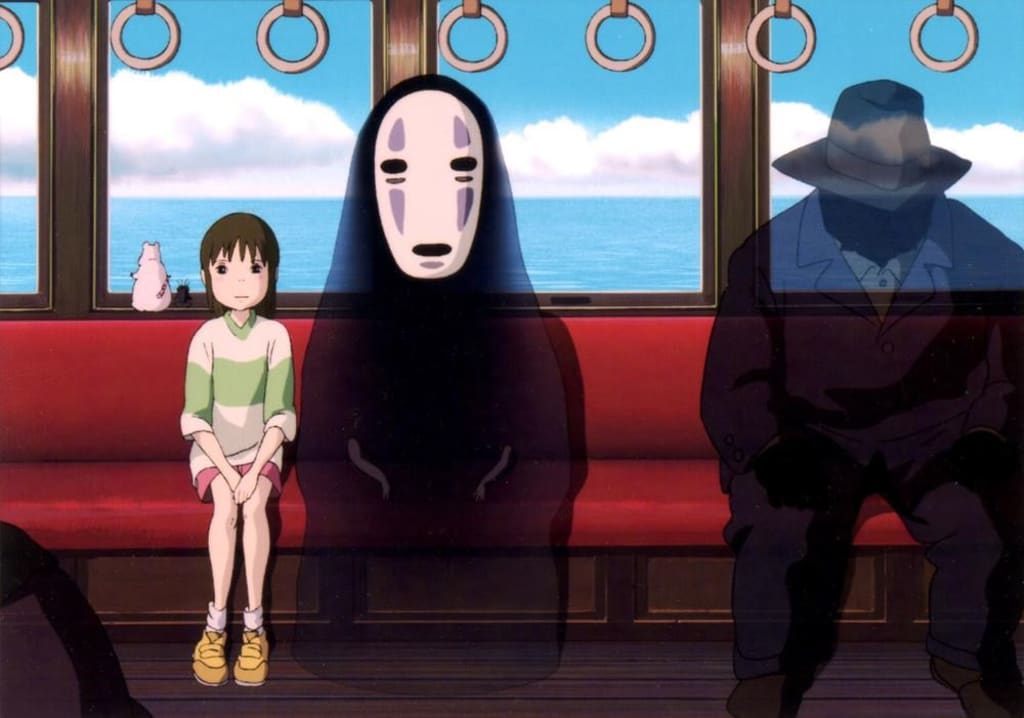'Spirited Away' and 'Alien'
Persistence Against Faceless Monsters

"Now, here, you see, it takes all the running you can do, to keep in the same place."
Through the Looking Glass.
In the beginning of Spirited Away, Chihiro witnesses subtle changes in her parents behavior, as their curiosity for an abandoned theme park grows. They start to forget about Chihiro and end up feasting on unexplained food that just appeared in a restaurant. As their eating the food grows more disgusting and piglike, they slowly turn into pigs, to the horror of Chihiro.
We don’t talk about this a lot, but in a movie distributed by Disney, parents are transformed into pigs, child labor and prostitution is tackled, and globalized capitalism is evoked as a faceless power that is destroying the very fabric of our humanity.
The level of detail Miyazaki asks of his crew in their craft is always astounding and the kids are spared no details of the bizarre compulsion that takes the parents, while they’re gobbling down lushly colored items of Japanese cuisine. Among other scenes that would probably never make it in a western animated movie intended for kids, there are scenes involving the creature called the No-Face.
Not a lot is known about it, except that it is the last step of dissolve of a character that probably spent a long while in the spirit world. There is a possibility that No-Face was a child, who, like Chihiro, got stranded in the spirit realm and slowly turned into this creature.
What fascinated me when I watched the movie again was how eerily similar this character seemed to the Alien from Giger and Ridley Scott's nightmarish visions. It’s not just that its color is primarily black and that it ends up devouring people. The No-Face mimics its prey's characteristics. The Alien from the eponymous movie works in an interestingly similar fashion. The face-hugger jumps from its egg to choke its victims, and depending on what species the victim is, the result will end up being different. The No-Face devours a frog in the realm of spirits and is thus given its voice and its ability to leap. There is something really scary about a creature that copies your own abilities. As you disappear, the void sucks up your energy, your history, your culture, and spits out a demonized version of yourself.
The similarities between the two movies don’t stop there. Chihiro and Ripley both have to progress in a terrifyingly big and hostile environment, disconnected from nature. The Bathhouse is a place made of fake traditional Japanese architecture. The bridge on which Chihiro gazes at the spirits coming to rest through the steam boat is not just made of wood, it’s reinforced with metal. The back of the Bathhouse is a nightmarish construction that looks like a 19th century English factory. The Nostromo and the Bathhouse are both symptomatic of a capitalistic economy gone haywire. I’m not going to pretend that Weyland Yutani and Yubaba have anything in common in terms of characters traits, but they both epitomize a similar view of capitalism where the love for profit outweighs the interest in people, but more importantly, their culture.
The Alien and No-Face chillingly evoke the absolute black void of a cultureless environment. What makes the alien and the No-Face terrifying ideas, beyond their genius visuals, is the fact they represent not only the void of space and the existential dread of our ultimate comeuppance, but the fact that this hopeless and infinite void is actually looking back. At us.
There is an interesting argument about the fact that the No-Face mimicked human greed, and that is why it becomes such a disturbing, all ingurgitating, power. The same way, people theorize that the Alien becomes predatory, not just a parasite, because it mimicked mankind, up to its terrifying and predatorial behavior.
I don’t think I’ll ever be able to watch Chihiro being chased by No-Face in the corridors or the alienating bathhouse without seeing the Alien chasing Ripley in the buzzing and alarm-blaring of the Nostromo. Ripley and Chihiro both knew the place was not right, both anticipated something truly wicked in their environment, both have to defeat the odds.
Where Alien and Spirited Away truly part ways is in the fact that Chihiro can see through the alienated creatures of the bathhouse into their original selves. Chihiro's main mission is to deliver ancient entities that lost their way into modernism: she delivers the God of the River from its trash, shell, Haku the dragon from his curse, and the No-Face from his man-made hunger. What ultimately makes Chihiro a kid’s movie, is that noble optimism that makes children reinvest meaning and hope in what seems lost and long gone. It’s also what makes this movie such a poignant plea for honesty, hard work, simplicity and meditation around our own selves. When Ripley discovers the truth behind Ash the android, there’s only more artificiality, deception, and control. When Chihiro discovers the truth behind Yubaba, the god river and Haku, there’s loss, anger and sorrow, yes, but there’s also a well of untapped kindness, patience, and reserve.
Alien of course, is making a much bleaker statement. What was alienated stays destroyed, the transformed can’t get back to its former self. Its cosmic horror is a statement of constant mutability and of the void that will ultimately devour us. And even if those movies make the never-ending attempt at delaying the inevitable inspiring, the characters' ultimate demise is bound to happen two movies down the line. (Looking at you, Alien 3)
But that doesn’t mean Spirited Away cheats with its happy end. What makes this animated treasure truly stand out is in the way it addresses the fear of alienation, the loss of our own selves and others under the corruptive nature of society and our man-made destruction. In its payoff, Chihiro gives Haku his essence back: it comes from a place of genuine moral fortitude and strength on her part. Chihiro and Ripley share this knack for survival and good intentions fully realized and that’s part of what make those character truly special.
If Ripley’s cleverness and sense of survival appear during the first encounter with the creature, as she’s the only one to recognize the face-hugger for an actual problem, Chihiro’s own ability to overcome the odds appear specifically in what slowly became my favorite scene during many of my reviewings, even though it seems anecdotal.
As Chihiro must progress in the bathhouse at the beginning of the movie, she discovers she must climb down the stairs. As a self-contained episode, this moment is great because of how relatable it is. Of course, as children, we all have experienced stairs in a house that were too wide and far apart. I can’t remember how many times I fell down the stairs. This episode is really important for Chihiro, because this is the moment she is proving herself and to audience that she will actually be up to the task that lies ahead and not end up as the very creature that pursues her during her adventure. The fact that the stairs are too big for her is a fascinating design choice, because it also works within the motive of the Uncanny, as Freud explains it: The stairs are familiar, but those are too wide and are not designed for her, the same way she does not belong in the bathhouse. Ultimately, she runs down, head on, eyes closed and manages to make her way to the next step. It's only the first trial in a long series. She has to run a lot to remain the smart and caring little girl she is, and not turn into Yubaba or the No-Face.
The way the world around Chihiro is, to me, the farthest you can get from the heartwarming eye-popping world of Super Mario. The core design of the Mario videogame works as follows: first, the developers assign the movements to the character, they decide what new ability they will, the Italian plumber, then everything, every platform, branch, and creatures are designed around those abilities. The world is literally tailor-made for the character. As level design and control get better in our time, playing Mario is not a challenge, it’s an act of pure joy that keeps on rewarding you without opposing real challenge. True, there is joy in this, and there is a lot of fun to have, but where is the inspiration? That’s the main difference between a cute, albeit shallow, plumber of a character and Chihiro. Her strength lies in her being true to who she is, not to her changing.
In a way, Mario is akin to Dorothy, who was given the shoes, and the yellow brick road to trot on. Those are not tales of overcoming the odds, those are tales of privilege and rewards. Following the steps is all Dorothy and Mario have to do. There’s nothing with the Wicked Witch Dorothy can’t undo. The bucket of water is right there. This is the genial kid’s story, something shiny and heartwarming.
What makes Spirited Away and Alien truly special, inspiring tales for children and adults, resides in the right balance of horror, wonderment and danger. Chihiro and Ripley constantly run inside hellish places just to be able to breathe and not be erased. In a world where the vacuum of death, memory loss, and unhinged capitalism can consume you at every turn, Chihiro and Ripley not only work within the rules that were clearly designed to fail them in the first place, but they also challenge those rules for a the betterment of their fellow employees and to restore balance and equilibrium.
For this reason, I can't think of much better role models for little girls out here right now. Both are marvels to look at, while getting to the core of what horror can feel like. As poignant arguments for resilience and fighting against a system that's designed to oppress and change you, Alien and Spirited Away are as timely as they are timeless.
About the Creator
Public Mistake
They told me you couldn't compare Madame Bovary and Fargo. They were absolutely right. But I did it anyway.
What's up? I have articles about everything, Soft Boys, Alien, Twitter, I might write something about avodado spread, IDK.






Comments
There are no comments for this story
Be the first to respond and start the conversation.